
Meyers Konversations-Lexikon or Meyers Lexikon was a major encyclopedia in the German language that existed in various editions, and by several titles, from 1839 to 1984, when it merged with the Brockhaus Enzyklopädie.

The Brockhaus Enzyklopädie is a German-language encyclopedia which until 2009 was published by the F. A. Brockhaus printing house.

The Battle of Saalfeld took place on 10 October 1806, at which a French force of 12,800 men commanded by Marshal Jean Lannes defeated a Prussian-Saxon force of 8,300 men under Prince Louis Ferdinand. The battle took place in Thuringia in what was the Ernestine duchy of Saxe-Coburg-Saalfeld. The battle was the second clash in the Prussian Campaign of the War of the Fourth Coalition.

Ludwig Alexander Friedrich August Philipp Freiherr von Falkenhausen was a German officer most notable for his activities during World War I.

The German publishing company Bibliographisches Institut was founded 1826 in Gotha by Joseph Meyer, moved 1828 to Hildburghausen and 1874 to Leipzig. Its production over the years includes such well-known titles as Meyers Lexikon, Brehms Tierleben ; Duden ; Meyers Reisebücher ; Meyers Klassiker ; atlases, newspapers and others.

A royal guard is a group of military bodyguards, soldiers or armed retainers responsible for the protection of a royal family member, such as a king or queen, or prince or princess. They often are an elite unit of the regular armed forces, or are designated as such, and may maintain special rights or privileges.

The Province of Brandenburg was a province of Prussia from 1815 to 1945. Brandenburg was established in 1815 from the Kingdom of Prussia's core territory, comprised the bulk of the historic Margraviate of Brandenburg and the Lower Lusatia region, and became part of the German Empire in 1871. From 1918, Brandenburg was a province of the Free State of Prussia until Prussia was dissolved in 1945 after World War II, and replaced with reduced territory as the State of Brandenburg in East Germany, which was later dissolved in 1952. Following the reunification of Germany in 1990, Brandenburg was re-established as a federal state of Germany, becoming one of the new states.
The 5th Guard Regiment of Foot was a regiment in the Prussian Army prior to and during the First World War. Established in 1897, it was part of the 5th Guards Infantry Brigade and the 2nd Guards Division. During peacetime the regiment was garrisoned in Spandau.

The Electorate of Saxony, also known as Electoral Saxony, was a territory of the Holy Roman Empire from 1356–1806. Its territory included the areas around the cities of Dresden, Leipzig and Chemnitz.

A Garde du Corps is a military unit, formed of guards. A Garde du Corps was first established in France in 1445. From the 17th century onwards, the term was used in several German states and also, for example, in the Kingdom of Two Sicilies for several regiments of heavy cavalry, whose proprietary colonel was usually the sovereign.
The 25th Division, officially the Grand Ducal Hessian (25th) Division, was a unit of the Prussian/German Army. It was headquartered in Darmstadt, the capital of the Grand Duchy of Hesse. The division was subordinated in peacetime to XVIII Army Corps when that corps was formed in 1899. The division was disbanded in 1919, during the demobilization of the German Army after World War I.
The 3rd Guards Infantry Division was a unit of the German Army, in World War I. The division was formed on the mobilization of the German Army in August 1914 as part of the Guards Reserve Corps. The division was disbanded in 1919, during the demobilization of the German Army after World War I. It was a division of the Prussian Guards and was thus raised and recruited throughout the Kingdom of Prussia from the elite of recruits.
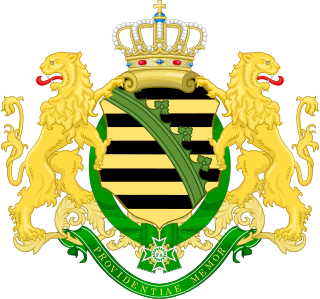
The Royal Saxon Army was the military force of the Electorate (1682–1807) and later the Kingdom of Saxony (1807–1918). A regular Saxon army was first established in 1682 and it continued to exist until the abolition of the German monarchies in 1918. With the formation of the Confederation of the Rhine by Napoleon the Royal Saxon Army joined the French "Grande Armée" along with 37 other German states.
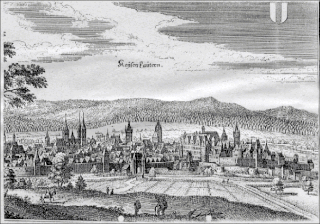
The Battle of Kaiserslautern saw a Coalition army under Charles William Ferdinand, Duke of Brunswick-Wolfenbüttel oppose a Republican French army led by Lazare Hoche. Three days of conflict resulted in a victory by the Prussians and their Electoral Saxon allies as they turned back repeated French attacks. The War of the First Coalition combat was fought near the city of Kaiserslautern in the modern-day state of Rhineland-Palatinate, Germany, which is located about 60 kilometres (37 mi) west of Mannheim.
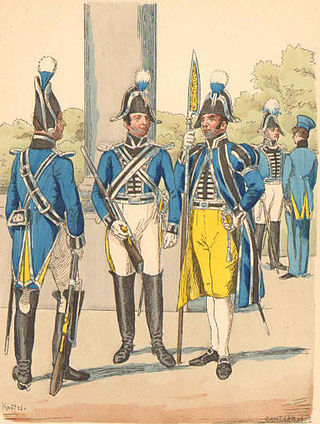
Hartschiere were predominantly members of the Bavarian residence guards before 1918, a historic military branch of the former Duchy and the later Electorate and at last Kingdom of Bavaria.
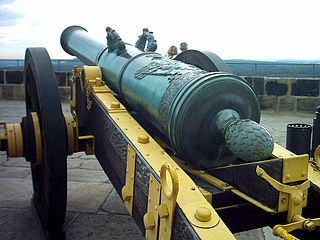
A kartouwe is a siege gun used in European warfare during the 16th and 17th centuries. The name kartouwe is of Dutch origin, a corruption of Latin quartana. In the Holy Roman Empire the gun was called Kartaune in German or cartouwe in contemporary Latin usage, in the Swedish Empire Kartow, spelling variants include kartouw, kartouve, cartow, cartaun, courtaun, and others.
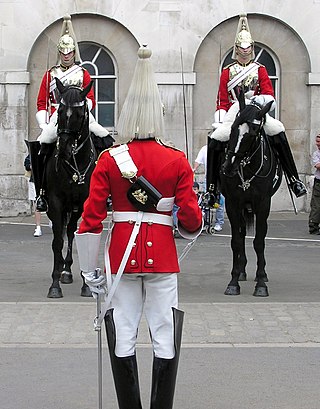
A life guard is a military unit charged with protecting a high-ranking individual, such as a monarch.
The 13 Cuirassier regiments of Old Prussia were formed in the mid-17th to mid-18th centuries, and formed the basis of Frederick the Great's vaunted cavalry.
The military ranks of the German Empire were the ranks used by the military of the German Empire. It inherited the various traditions and military ranks of its constituent states.

The Danish Auxiliary Corps was a corps of 7,000 Danish soldiers sent to fight with William of Orange who was at war in Ireland. Disappointed with his alliance with France's King Louis XIV, Christian V of Denmark–Norway in 1689 entered into a treaty of military assistance with King William III of England. The corps was transported to Ireland, fighting against the Jacobites, participating in the battles of the Boyne and Aughrim, as well as the sieges of Limerick, Cork, Kinsale, Athlone, and Galway. In early 1692 the corps was transported to Flanders for future service in English pay.
















